Chiropractic and Disc Herniations
A disc herniation is when there is a problem with one of the rubbery cushions (discs) that sit between the bones that stack up to form your spine. The disc is made up of a nucleus which is found in the center of the disc and contains a soft jelly-like substance. Surrounding the nucleus is a tough exterior called the annulus that supports the contents of the nucleus.
The three most common causes of disc herniations is usually from either:
This can cause the jelly-like substance from the nucleus to be spilled out due to a tear within the annulus and into the spinal canal. Since the space in the spinal canal is limited this jelly like substance can irritate the surrounding nerve which can result in pain.
A herniated disc can occur in any part of the spine but most commonly occurs in the lower back but can also happen on the neck.
Some people can be asymptomatic but others may present with symptoms such as: 1. Arm pain/leg pain
2. Numbness or tingling
3. Weakness
4. Neck/back pain.
5. Pain, numbness or tingling when coughing, sneezing or straining.
Fortunately, the majority of herniated discs do not require surgery. With time, the symptoms improve in approximately 9 out of 10 people. The time to improve varies, ranging from a few days to a few weeks.
Limit activities for 2 to 3 days. Walking as tolerated is encouraged, along with an anti-inflammatory, such as ibuprofen, if not contraindicated for the patient.
Bedrest is not recommended.
Primary care evaluation during this time may lead to considering other non-surgical treatments such as physical therapy which includes chiropractic. Your chiropractor will do a thorough history along with physical tests/imaging (neurological, orthopedic, spinal exam and potentially an x-ray/MRI) to determine the diagnosis and the best course of action to help in your recovery. Your chiropractor will use low force techniques to relieve painful symptoms by adjusting your spine which can help to take the pressure of the disc. Chiropractic treatment for bulging or herniated discs is safe, effective, and long lasting. If you are having back pain from a disc problem, you owe it to yourself to seek quality chiropractic care so that you can enjoy less pain, improved mobility, and better quality of life.
How Chiropractic Care Can Help
Chiropractic care may help to reduce pressure on your discs and also overall body, therefore contributing to less stress on your spinal discs.
What To Expect At Your First Chiropractic Visit
An initial Chiropractic exam for back pain will typically have three parts: a consultation, case history, and physical examination. Laboratory analysis and X-ray examination may be performed.
Consultation. The patient meets with the chiropractor and provides a brief synopsis of his or her lower back pain, such as:
Duration and frequency of symptoms
Description of the symptoms (e.g. burning, throbbing)
Areas of pain
What makes the pain feel better (e.g. sitting, stretching)
What makes the pain feel worse (e.g. standing, lifting).
Case history. The chiropractor identifies the area(s) of complaint and the nature of the back pain by asking questions and learning more about different areas of the patient's history, including:
Family history
Dietary habits
Past history of other treatments (chiropractic, osteopathic, medical and other)
Occupational history
Psychosocial history
Other areas to probe, often based on responses to above questions
Physical examination. A chiropractor may utilize a variety of methods to determine the spinal segments that require chiropractic treatments, including but not limited to static and motion palpation techniques determining spinal segments that are hypo mobile (restricted in their movement) or fixated. Depending on the results of the above examination, a chiropractor may use additional diagnostic tests, such as:
X-ray to locate subluxations (the altered position of the vertebra)
A device that detects the temperature of the skin in the paraspinal region to identify spinal areas with a significant temperature variance that requires manipulation.
Chiropractors are trained in a variety of methods to assess the underlying cause of the problem, including:
Evaluation and management services. Chiropractors are trained in examining the joints, bones, muscles and tendons of the spine, head, extremities and other areas of the body with the purpose of noting any misalignment, tenderness, asymmetry, defects or other problems.
Neurologic and other common physical examination procedures. Chiropractors are trained to perform a variety of neurologic tests (nerve root compression/tension, motor strength, coordination, deep tendon and pathological reflexes, etc.) and are skilled in performing orthopedic, cardiovascular and many other common examinations.
Specialised assessment. Chiropractors are trained to assess range of motion, stability, muscle strength, muscle tone and other assessments with the lower back.
Common diagnostic studies. Chiropractors are trained in use of diagnostic studies and tools such as radiography (X-rays), laboratory diagnostics and neurodiagnostics.
References:
https://www.mayoclinic.org/diseases-conditions/herniated-disk/symptoms-causes/syc-20354095
https://www.knoxchiropractic.com/blog/14559-can-chiropractic-help-with-bulging-or-herniated-di scs
https://www.aans.org/en/Patients/Neurosurgical-Conditions-and-Treatments/Herniated-Disc
https://www.ncbi.nlm.nih.gov/pmc/articles/PMC2647024/
https://thejns.org/focus/view/journals/neurosurg-focus/15/3/foc.2003.15.3.10.xml





